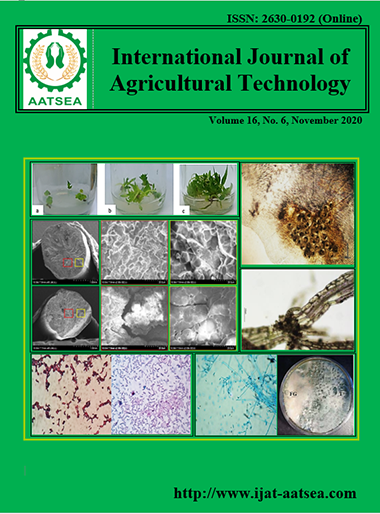Effect of sterility value on qualities of Chinese braised culled steer beef in retort pouch
Main Article Content
Abstract
The results showed that their cook values were 72.42, 87.05 and 95.04 min, respectively. Microbiological analysis and sterility test were proved that the samples were safety for microbiological quality. However, parameters of texture profile (hardness, gumminess, springiness and chewiness) decreased as F0 value was increased (p<0.05). Similarly, shear force decreased with increasing F0 value (p<0.05). The CIE L* value increased and CIE a* values decreased as F0 value was increased. For sensory evaluation, semi-trained panelists mostly impressed this product which produced by F0 value of 10 min (p<0.05). Therefore, the development of Chinese braised beef in retort pouch was satisfied with F0 value of 10 min.
Article Details

This work is licensed under a Creative Commons Attribution-NonCommercial-NoDerivatives 4.0 International License.
References
BAM (2001a). Aerobic Plate Count. U.S. Food and Drug Administration. Retrieved from https://www.fda.gov/food/laboratory-methods-food/bam-aerobic-plate-count.
BAM (2001b). Yeasts and Molds. U.S. Food and Drug Administration. Retrieved from https//www.fda.gov/food/laboratory-methods-food/bam-yeasts-molds-and-mycotoxins.
BAM (2001c). Staphylococcus aureus. U.S. Food and Drug Administration. Retrieved from https://www.fda.gov/food/laboratory-methods-food/bam-staphylococcus-aureus.
BAM (2001d). Clostridium perfringens. U.S. Food and Drug Administration. Retrieved from https://www.fda.gov/food/laboratory-methods-food/bam-clostridium-perfringens.
BAM (2002). Escherichia coli and the Coliform. U.S. Food and Drug Administration. Retrieved from https//www.fda.gov/food/laboratory-methods-food/bam-4-enumeration-escherichia-coli-and-coliform-bacteria.
BAM (2007). Clostridium botulinum. U.S. Food and Drug Administration. Retrieved from https//www.fda.gov/food/laboratory-methods-food/bacteriological-analytical-manual-bam-chapter-5-salmonella.
Bindu, J., Ravishankar, C. N. and Gopal, T. S. (2007). Shelf life evaluation of a ready-to-eat black clam (Villorita cyprinoides) product in indigenous retort pouches. Journal of Food Engineering, 78:995-1000.
Bindu, J., Ravishankar, C. N. and Srinivasa Gopal, T. K. (2008). Investigation of shelf life and heat penetration attributes of ready – to – eat “fish peera” from anchovy (Stolephorous commersoni) in tetort pouches. Journal of Food Processing and Preservation, 34:207-222.
Bourne, M. C., Kenny, J. F. and Barnard, J. (1978). Computer assisted readout of data from texture profile analysis curves 1. Journal of Texture Studies, 9:481-494.
Brennan, J. G., Butters, J. R., Cowell, N. D. and Lilly, A. E.V. (1990). Food Engineering Operations, 3rd ed. London, Applied Science Publishers.
Chumngoen, W., Chen, C. F. and Tan, F. J. (2018). Effects of moist and dry heat cooking on the meat quality, microstructure and sensory characteristics of native chicken meat. Animal Science Journal, 89:193-201.
Gopinath, S. P., Kochery Anthony, M. X., Nagarajarao, R. C., Jaganath, B. and Krishnaswamy, S. G. T. (2007). Standardisation of process parametres for ready-to-eat squid masala in indigenous polymer-coated tin-free steel cans. International Journal of Food Science and Technology, 42:1148-1155.
IS Indian Standard (1971). IS2168. Specification for pomfret canned in oil. New Delhi, India, Indian Standards Institution.
Maheswara, K. J., Raju, C. V., Nail, J., Prabhu R. M. and Panda K. (2011). Studies on thermal processing of tuna - a comparatibe study in tin and tin - free steel cans. African Journal of Jood Agriculture Nutrition and Development, 11:5539-5560.
Majumdar, R. K., Dhar, B., Roy, D. and Saha, S. (2015). Study of instrumental and sensory characteristics of catla in curry medium during retort pouch processing to optimize F0 value. Journal of Food Processing and Preservation, 39:1595-1604.
Mohan, C. O., Ravishankar, C. N., Bindu, J., Geethalakshmi, V. and Gopal, T. K. S. (2006). Effect of thermal process time on quality of “shrimp kuruma” in retortable pouches and aluminum cans. Journal of Food Science, 71:496-500.
Moon, S. S. (2006). The effect of quality grade and muscle on collagen contents and tenderness of intramuscular connective tissue and myofibrillar protein for Hanwoo beef. Asian-Australasian Journal of Animal Sciences, 19:1059-1064.
Palka, K. (1999). Changes in intramuscular connective tissue and collagen solubility of bovine m. semitendinosus during retorting. Meat Science, 53:189-194.
Ranganna, S. (2002). Handbook of Canning and Aseptic Packaging. New Delhi, India, Tata McGraw-Hill Publishing Co., Ltd.
Shah, M. A., Bosco, S. J. D., Mir, S. A. and Sunooj, K. V. (2017). Evaluation of shelf life of retort pouch packaged Rogan josh, a traditional meat curry of Kashmir, India. Food Packaging and Shelf Life, 12:76-82.
Sorapukdee, S., and Tangwatcharin, P. (2018). Quality of steak restructured from beef trimmings containing microbial transglutaminase and impacted by freezing and grading by fat level. Asian-Australasian Journal of Animal Sciences, 31:129-137.
SPSS. (2008). SPSS for windows. Release 17. SPSS Inc., Chicago, IL.
Tribuzi, G., ARAGÃO, G. M. F. D. and Laurindo, J. B. (2015). Processing of chopped mussel meat in retort pouch. Food Science and Technology, 35:612-619.


